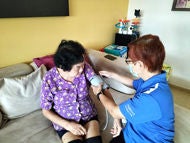What is - Prostatic Artery Embolisation
Prostatic artery embolisation (PAE) is a minimally invasive, non-surgical procedure used to treat benign prostatic hyperplasia (BPH). BPH is a non-cancerous enlargement of the prostate gland. It normally affects men over 40, and two out of every ten men with the condition will eventually require a procedure to relieve its symptoms.
PAE involves blocking the blood supply to the enlarged prostate, which causes the gland to shrink over time. This procedure is typically performed by an interventional radiologist using small catheters (tubes) under specialised imaging guidance.

How does prostatic artery embolisation work?
PAE works by reducing blood flow to the prostate, which causes the gland to shrink over time. The procedure is performed by inserting a thin tube (catheter) into a blood vessel, usually in the groin or left wrist. After numbing the area with local anaesthetic, the doctor uses real-time X-ray imaging and a special dye to guide the catheter to the blood vessels that supply the prostate.
As the dye moves through the body, you may feel a brief warm sensation or the urge to urinate, which quickly passes. Once the correct location is reached, tiny particles — smaller than a strand of hair — are released to block the blood supply to the prostate.
Prostatic Artery Embolisation – Benefits
What are the benefits of prostatic artery embolisation?
Prostatic artery embolisation offers several advantages for individuals with benign prostatic hyperplasia, particularly those who may not be suitable for traditional surgery. Key benefits include:·
- Minimally invasive approach: The procedure does not require general anaesthesia or surgical incisions, reducing the risk of complications and shortening recovery time.
- Reduced urinary symptoms: Most patients experience significant improvement in symptoms such as frequent urination, weak stream or urgency.
- Lower risk of sexual side effects: Compared to conventional surgery, PAE is associated with a lower risk of affecting sexual function or causing retrograde ejaculation.
- Outpatient or short hospital stay: In many cases, patients return home on the same day or after a brief observation period.·
- Suitable for high-risk patients: PAE may be a safer alternative for those with other medical conditions that increase surgical risk.
- Suitable for patients on blood thinners: The risk of bleeding is much less compared to surgery.
Who is suitable for prostatic artery embolisation?
Prostatic artery embolisation (PAE) is primarily used to manage anyone with symptoms caused by benign prostatic hyperplasia (BPH).
It may be considered in the following situations:
- When symptoms of BPH, such as frequent urination or difficulty emptying the bladder, affect quality of life
- When medications for BPH have not been effective or cause unwanted side effects
- When surgery is not advised due to other health concerns or patient preference (unfit for general anaestheisa or TURP)
- For patients who are unwilling or unsuitable for surgery (median lobe) Patients who are on long-term urinary catheter because of BPH may have this procedure to get rid of the catheter (success rate is over 85%)
- For patients seeking a treatment option with a lower risk of sexual side effects compared to traditional surgeryIn cases where prostate size is particularly large, and alternative procedures may carry greater risk
- When a patient wishes to avoid hospital admission and prefers a quicker recovery time
- For control of bleeding after prostate biopsy or prostatectomy
Prostatic Artery Embolisation – Limitations
What are the limitations of prostatic artery embolisation?
While prostatic artery embolisation (PAE) is a promising treatment for many patients, it has certain limitations:
- Patient suitability: Some individuals may have complex or narrow arteries that make the procedure technically challenging or unsafe. This will be seen on the pre-procedure scans.
- Variable outcomes: Symptom relief can vary between patients, and some may experience only partial improvement.
- Limited long-term data: Although short- and medium-term results are encouraging, long-term effectiveness compared to surgical options is still being studied.
- Possible need for further treatment: In some cases, symptoms may return over time, and additional procedures or medications may be required.
It is important to discuss with your healthcare provider on whether PAE is the most appropriate option for your condition.
Prostatic Artery Embolisation - Causes and Risk Factors
What are the risks associated with prostatic artery embolisation?
Prostatic artery embolisation (PAE) is generally considered safe, but as with any medical procedure, there are potential risks and safety considerations:
- Minor side effects: Some patients may experience bruising, discomfort or swelling at the catheter insertion site.
- Non-target embolisation: There is a small risk that embolic particles may unintentionally block blood flow to nearby organs or tissues.
- Allergic reactions: Some individuals may react to the contrast dye used during the procedure.
- Infection: As with any procedure involving catheter insertion, there is a risk of infection at the access site.
- Urinary retention: Temporary difficulty passing urine may occur in some patients after embolisation.
- Incomplete relief: In rare cases, symptoms may not improve significantly or additional treatment may be necessary.
Pre-Surgery Preparation for Prostatic Artery Embolisation
How can you prepare for a prostatic artery embolisation?
Preparation for prostatic artery embolisation (PAE) involves several important steps to ensure the procedure is carried out safely and effectively. Your healthcare team will provide personalised instructions, but general preparations include:
- Medical review: A pre-procedure consultation to discuss your medical history, symptoms and current medications.
- Diagnostic tests: Blood tests and imaging scans to assess the size and blood supply of the prostate gland.Medication adjustments: Temporary discontinuation of blood-thinning medicines, if advised by your doctor.
- Fasting: No food or drink for several hours before the procedure, typically after midnight on the day of admission.
- Preparing for transport: Arranging for someone to accompany you and take you home afterwards, as you may feel drowsy after sedation.
Prostatic Artery Embolisation – During the Procedure
What can you expect during prostatic artery embolisation?
Knowing what to expect on the day of your prostatic artery embolisation (PAE) can help reduce anxiety and make you feel more prepared.
- Arrival and preparation: You will be asked to arrive at the hospital a few hours before the procedure. A nurse will check your vital signs, and you may be asked to change into a hospital gown. A small cannula will be placed in your arm for fluids or medication.
- Positioning and comfort: You will lie on your back on an X-ray table in the procedure room. A local anaesthetic will be used to numb the access site, usually in the groin or wrist. You may feel a brief sting or some pressure, but the area will become numb quickly.
- During the procedure: You will remain awake and may be offered mild sedation to help you relax. You may feel light pressure as the catheter is guided through your blood vessels. When the contrast dye is used, a warm sensation or the urge to urinate is common and usually passes quickly.
- Mild discomfort: Most patients experience little to no pain. Some may feel mild cramping or discomfort in the pelvis as the particles are released, but this is usually short-lived.
- Monitoring and recovery: After the procedure, you will be taken to a recovery area. Your heart rate, blood pressure and access site will be monitored. You may need to lie flat for a short period to minimise the risk of bleeding.
- Going home: Many patients return home the same day, although some may stay overnight for observation. You will receive instructions on aftercare, including which activities to avoid and when to seek medical advice.
Post-Surgery Care for Prostatic Artery Embolisation
What can you expect after prostatic artery embolisation?
Recovery following prostatic artery embolisation (PAE) is usually straightforward, with most patients experiencing only mild side effects. You will be given an antibiotic and medicines to reduce the inflammation (e.g., ibuprofen) to take for few days. Understanding what to expect during the days and weeks after the procedure can help you feel more prepared:
- Mild discomfort: It is common to experience a mild burning sensation in the perineum. This discomfort is typically mild and can be managed with simple pain relief.
- Fatigue: You may feel tired or low in energy for a few days following the procedure. Rest is recommended, and most individuals begin to feel better within a week.
- Urinary symptoms: Some urinary symptoms may continue or temporarily worsen before they improve. These may include frequent urination, urgency or a weak stream. This is expected as the prostate gradually reduces in size.
- Post-embolisation syndrome: A small number of patients may develop a low-grade fever, nausea or mild flu-like symptoms. These usually settle within a few days without treatment.
- Wound care: The access site, usually in the groin or wrist, should be kept clean and dry. Some bruising or tenderness is normal and should resolve over time.
- Activity restrictions: You should avoid strenuous exercise and heavy lifting for a week. You may return to light activity or work when you feel ready.
- Follow-up: A follow-up appointment will be arranged to assess your recovery and evaluate how well the treatment has worked.
Prostatic Artery Embolisation - Other Information
Can prostatic artery embolisation affect sexual function?
While traditional surgical treatments for an enlarged prostate may carry a risk of sexual side effects such as erectile dysfunction or retrograde ejaculation, prostatic artery embolisation has shown a lower risk of these complications. Most patients maintain normal sexual function after the procedure.
How soon will I notice an improvement in symptoms after PAE?
Many patients begin to notice relief from urinary symptoms within two to six weeks following the procedure. However, the prostate continues to shrink gradually over several months, and full benefits may not be felt until three to six months post-procedure.
What size of prostate is suitable for prostatic artery embolisation?
Prostatic artery embolisation is typically recommended for men with moderately to significantly enlarged prostates, often greater than 40 grams in volume. However, suitability also depends on factors such as arterial anatomy and symptom severity. Imaging and clinical evaluation are used to determine if the procedure is appropriate for each patient.
References
Yale Medicine. (n.d.). Prostatic artery embolization. https://www.yalemedicine.org/conditions/prostatic-artery-embolization
Barbosa, R. M., Moreira, A. M., & Carnevale, F. C. (2023). Prostatic artery embolisation for benign prostatic hyperplasia. The Lancet Regional Health – Europe, 27, 100591. https://www.thelancet.com/journals/lanepe/article/PIIS2666-7762(23)00091-1/fulltext
de Assis, A. M., Moreira, A. M., de Paula Rodrigues, V. C., Yoshinaga, E. M., Antunes, A. A., Srougi, M., & Carnevale, F. C. (2021). Prostatic artery embolization for benign prostatic hyperplasia: A review of anatomy and technique. RadioGraphics, 41(5), 1401–1417. https://pubs.rsna.org/doi/full/10.1148/rg.2021200144
McWilliams, J. P. (2022). Commentary on: Prostatic artery embolization vs. transurethral resection of the prostate for benign prostatic hyperplasia: 2-year outcomes from a randomised, open-label, single-centre trial. The Journal of Urology, 207(6), 1151–1152. https://www.auajournals.org/doi/10.1097/JU.0000000000003976
Contributed by
The information provided is not intended as medical advice. Terms of use. Information provided by SingHealth.



















